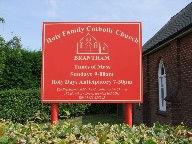| |
|
 |
|
It was the summer
of 2001, I should think, and we were on
our way to a garden fete. Nothing wrong
with that, except that it was in Mistley.
"But that's in Essex",
I complained. My wife gave me her look,
which means "if you are going to
behave like an obsessive, then I shall
start treating you like one". My
four year old daughter is mastering the
same look. We all got in the car, and
headed for the border. Soon, we were
speeding out of Ipswich, past Alton
Water. This is not a good road for
cycling, so I was happy to be in a car.
We soon reached the Brantham Bull, and
the sharp dog-leg turn that leads into
Brantham itself.
As an act of mercy, we
stopped just short of the border, and I
was dropped outside Holy Family, a church
I'd never visited before. Brantham is,
essentially, a suburb of the Essex town
of Manningtree (I can hear the
complaining e-mails already being fired),
the River Stour separating it from its
larger, and prettier, neighbour. The old
village is still pleasant enough,
gathered around the medieval church of St
Michael, but the long
stretch into Manningtree is thoroughly
urban and industrialised.
|
It was at St Michael that the
Catholic priests of this parish ministered before
the Reformation. But that is now in Anglican
care, of course, and so now we have to go to this
functional little brick building if we want to go
to Mass. The dirty red brick detracts from the
cool simplicity of the windows. The church dates
from 1919. In those days, it was a parish church;
technically, it isn't any more, but through no
fault of its own.
A couple of miles away is the famous
village of East Bergholt, and it was there that a
Benedictine convent was established in the late
19th century. In 1946, the nuns left Old Hall, and their
building was taken over by a community of
Franciscans. The Franciscans administrated the
Brantham parish, providing priests to it. And
what a big parish it was! It extended northwards
to the heathlands south of Ipswich (where nobody
actually lived, so it was purely a stroke of a
bureacrats pen). And then, in the 1960s, the
great expansion southwards of Ipswich began.
Large parts of Sproughton civil
parish were taken within the Borough boundary,
and on the former Sproughton Chantry lands the
vast Chantry Estate was built, home to some
30,000 people. Interestingly, they all lived
within the Catholic Parish of Brantham, but
almost 8 miles from this church, which sits
snuggly in the south east corner.
The obvious thing was to build a
chapel of ease on Chantry, enabling Catholics
there to attend a Mass centre. The Diocese of
Northampton (in which, unlikely as this may seem,
Brantham then was) decided to go one step
further, building a large modern church on
Chantry, St Mark. This
would become the parish church, and Holy Family
at Brantham retreated to the status of a Mass
station. There was another Mass station halfway
between the two, at Capel St
Mary, where the Catholics shared the
Anglican parish church there. So Brantham must
feel quite isolated from its
daughter-turned-mother church, but it is
obviously still a lively place, judging by the
modern extension to the south. Indeed, there is
something wholly beautiful that has been added in
the last few years.
This
is Gabrielle Pready's stained glass of 1997,
installed in the apse-like ending behind the altar. One side
shows the Holy Family, the other the Blessed
Virgin. I should very much like to have
photographed them properly, but the church was
locked. It was still locked when I cycled this
way in the summer of 2009 (I am assuming it has
been open a few times in the intervening period,
obviously). I moan often enough about Anglican
churches being locked, but a Catholic church
should always be open, to enable the faithful to
enter into the presence of the Blessed Sacrament. The same
is not liturgically required of a chapel of ease
like this, but wouldn't it be nice?
I
am indebted to Dick Shively, an American
correspondent of the site, who took photographs
of the inside in May 2003. Dick and his wife
Anita had actually been married in the church in
1963, and had revisited for a 40th anniversary
Mass. You can see the eastwards view below, and a
close-up of the altar at the bottom. As you can
see, the church has been neatly reordered in the
Vatican II manner, and angled light pine benches
face towards to simple modern altar set in its
apse. There is a rood group set in relief on the
front of it. The walls are plain and white,
offsetting rather elaborate stations that may
have come from Old Hall. The
Pready glass contributes to a feeling of
lightness.
And
so, we headed onwards. I flinched slightly as we
crossed the border, but Mistley turned out to be
very nice after all. And the church
there was open.
|
|
|

